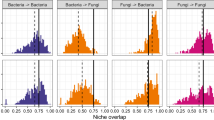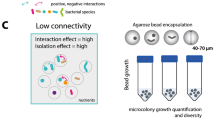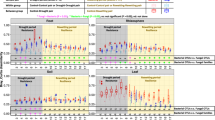Abstract
Competition can lead to the exclusion of bacterial taxa when there is a transitive relationship among competitors with a hierarchy of competitive success. However, competition may not prevent bacterial coexistence if competitors form intransitive loops, in which none is able to outcompete all the rest. Both transitive and intransitive competition have been demonstrated in bacterial model systems. However, in natural soil microbial assemblages competition is typically understood as a dominance relationship leading to the exclusion of weak competitors. Here, we argue that transitive and intransitive interactions concurrently determine the structure of soil microbial communities. We explain why pairwise interactions cannot depict competition correctly in complex communities, and propose an alternative through the detection of strongly connected components (SCCs) in microbial networks. We finally analyse the existence of SCCs in soil bacterial communities in two Mediterranean ecosystems, for illustrative purposes only (rather than with the aim of providing a methodological tool) due to current limitations, and discuss future avenues to experimentally test the existence of SCCs in nature.
This is a preview of subscription content, access via your institution
Access options
Subscribe to this journal
We are sorry, but there is no personal subscription option available for your country.
Buy this article
- Purchase on Springer Link
- Instant access to full article PDF
Prices may be subject to local taxes which are calculated during checkout


Similar content being viewed by others
References
Ghoul M, Mitri S. The ecology and evolution of microbial competition. Trends Microbiol. 2016;24:833–45.
Hibbing ME, Fuqua C, Parsek MR, Peterson SB. Bacterial competition: surviving and thriving in the microbial jungle. Nat Rev Microbiol. 2010;8:15–25.
Alcántara JM, Pulgar M, Rey PJ. Dissecting the role of transitivity and intransitivity on coexistence in competing species networks. Theor Ecol. 2017;10(2):207–15.
Laird RA, Schamp BS. Competitive intransitivity promotes species coexistence. Am Nat. 2006;168:182–93.
Kerr B, Riley MA, Feldman MW, Bohannan BJ. Local dispersal promotes biodiversity in a real-life game of rock-paper-scissors. Nature. 2002;418:171–174.
Riley MA, Gordon DM. The ecological role of bacteriocins in bacterial competition. Trends Microbiol. 1999;7:129–33.
Czárán TL, Hoekstra RF, Pagie L. Chemical warfare between microbes promotes biodiversity. Proc Natl Acad Sci USA. 2002;99:786–90.
Kirkup BC, Riley MA. Antibiotic-mediated antagonism leads to a bacterial game of rock-paper-scissors in vivo. Nature. 2004;428:412–14.
Higgins LM, Friedman J, Shen H, Gore J. Co-occurring soil bacteria exhibit a robust competitive hierarchy and lack of non-transitive interactions. BioRxiv (2017) 2017.08.16.175737. https://doi.org/10.1101/175737
Fiegna F, Velicer GJ. Exploitative and hierarchical antagonism in a cooperative bacterium. PLoS Biol. 2005;3:1980–7.
Goberna M, Verdú M. Cautionary notes on the use of co-occurrence networks in soil ecology. Soil Biol Biochem. 2022;166:108534.
Goberna M, Verdú M. Phylogenetic-scale disparities in the soil microbial diversity-ecosystem functioning relationship. ISME J. 2018;12:2152–62.
Conwill A, Kuan AC, Damerla R, Poret AJ, Baker JS, Tripp AD, et al. Anatomy promotes neutral coexistence of strains in the human skin microbiome. Cell Host Microbe. 2022;30:171–82.
Erktan A, Or D, Scheu S. The physical structure of soil: determinant and consequence of trophic interactions. Soil Biol Biochem. 2020;148:107876.
Levine JM, Bascompte J, Adler PB, Allesina S. Beyond pairwise mechanisms of species coexistence in complex communities. Nature. 2017;546:56–64.
Hallam TG, Svoboda LJ, Gard TC. Persistence and extinction in three species Lotka-Volterra competitive systems. Math Biosci. 1979;46:117–24.
Barabás G, Michalska-Smith MJ, Allesina S. The effect of intra-and interspecific competition on coexistence in multispecies communities. Am Nat. 2016;188:E1–12.
Friedman J, Higgins LM, Gore J. Community structure follows simple assembly rules in microbial microcosms. Nat Ecol Evol. 2017;1:0109.
Godoy O, Stouffer DB, Kraft NJ, Levine JM. Intransitivity is infrequent and fails to promote annual plant coexistence without pairwise niche differences. Ecology. 2017;98:1193–1200.
Allesina S, Levine JM. A competitive network theory of species diversity. Proc Natl Acad Sci USA. 2011;108:5638–42.
May RM. Will a large complex system be stable? Nature. 1972;238:413–14.
Alcántara JM, Rey PJ. Linking topological structure and dynamics in ecological networks. Am Nat. 2012;180:186–99.
Colin Y, Goberna M, Verdú M, Navarro-Cano JA. Successional trajectories of soil bacterial communities in mine tailings: the role of plant functional traits. J Environ Manag. 2019;241:284–92.
Chang C-Y, Bajic D, Vila J, Estrela S, Sanchez A. Emergent coexistence in multispecies microbial communities. bioRxiv (2022) 2022.05.20.492860; https://doi.org/10.1101/2022.05.20.492860
Piccardi P, Alberti G, Alexander JM, Mitri S. Microbial invasion of a toxic medium is facilitated by a resident community but inhibited as the community co-evolves. ISME J. 2022;16:2644–52.
Acknowledgements
We received grants PID2020-119634GB-I00, PID2020-113157GB-I00 and EUR2021-121995 funded by MCIN/AEI/10.13039/501100011033 and CIPROM/2021/63 from Generalitat Valenciana. JANC received grant RYC2019-026848-I also funded by MCIN/AEI and by “ESF Investing in your future”.
Author information
Authors and Affiliations
Contributions
MV, JMA and MG conceived the idea of the manuscript. JNC collected the data, and all authors contributed to data analyses. MV, JMA and MG wrote the first draft of the manuscript, which all authors reviewed.
Corresponding author
Ethics declarations
Competing interests
The authors declare no competing interests.
Additional information
Publisher’s note Springer Nature remains neutral with regard to jurisdictional claims in published maps and institutional affiliations.
Supplementary information
Rights and permissions
Springer Nature or its licensor (e.g. a society or other partner) holds exclusive rights to this article under a publishing agreement with the author(s) or other rightsholder(s); author self-archiving of the accepted manuscript version of this article is solely governed by the terms of such publishing agreement and applicable law.
About this article
Cite this article
Verdú, M., Alcántara, J.M., Navarro-Cano, J.A. et al. Transitivity and intransitivity in soil bacterial networks. ISME J 17, 2135–2139 (2023). https://doi.org/10.1038/s41396-023-01540-8
Received:
Revised:
Accepted:
Published:
Issue Date:
DOI: https://doi.org/10.1038/s41396-023-01540-8



